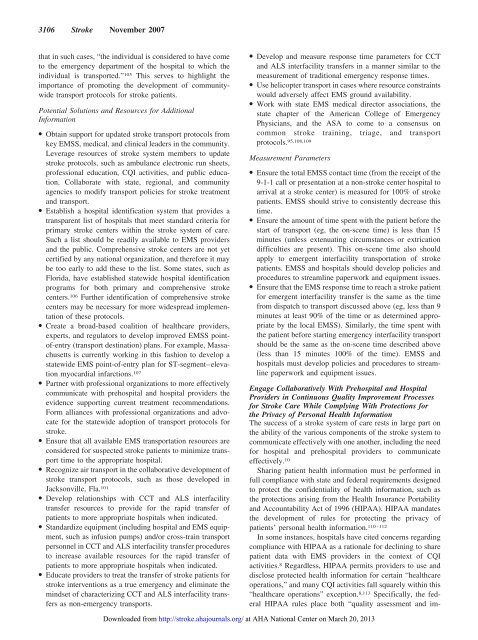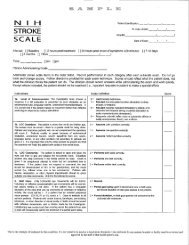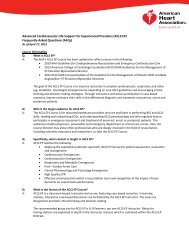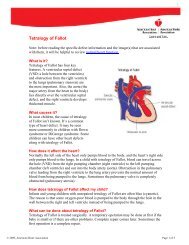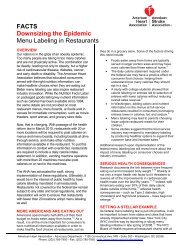2007 EMS Stroke Recommendations - American Heart Association
2007 EMS Stroke Recommendations - American Heart Association
2007 EMS Stroke Recommendations - American Heart Association
Create successful ePaper yourself
Turn your PDF publications into a flip-book with our unique Google optimized e-Paper software.
3106 <strong>Stroke</strong> November <strong>2007</strong><br />
that in such cases, “the individual is considered to have come<br />
to the emergency department of the hospital to which the<br />
individual is transported.” 105 This serves to highlight the<br />
importance of promoting the development of communitywide<br />
transport protocols for stroke patients.<br />
Potential Solutions and Resources for Additional<br />
Information<br />
● Obtain support for updated stroke transport protocols from<br />
key <strong>EMS</strong>S, medical, and clinical leaders in the community.<br />
Leverage resources of stroke system members to update<br />
stroke protocols, such as ambulance electronic run sheets,<br />
professional education, CQI activities, and public education.<br />
Collaborate with state, regional, and community<br />
agencies to modify transport policies for stroke treatment<br />
and transport.<br />
● Establish a hospital identification system that provides a<br />
transparent list of hospitals that meet standard criteria for<br />
primary stroke centers within the stroke system of care.<br />
Such a list should be readily available to <strong>EMS</strong> providers<br />
and the public. Comprehensive stroke centers are not yet<br />
certified by any national organization, and therefore it may<br />
be too early to add these to the list. Some states, such as<br />
Florida, have established statewide hospital identification<br />
programs for both primary and comprehensive stroke<br />
centers. 106 Further identification of comprehensive stroke<br />
centers may be necessary for more widespread implementation<br />
of these protocols.<br />
● Create a broad-based coalition of healthcare providers,<br />
experts, and regulators to develop improved <strong>EMS</strong>S pointof-entry<br />
(transport destination) plans. For example, Massachusetts<br />
is currently working in this fashion to develop a<br />
statewide <strong>EMS</strong> point-of-entry plan for ST-segment–elevation<br />
myocardial infarctions. 107<br />
● Partner with professional organizations to more effectively<br />
communicate with prehospital and hospital providers the<br />
evidence supporting current treatment recommendations.<br />
Form alliances with professional organizations and advocate<br />
for the statewide adoption of transport protocols for<br />
stroke.<br />
● Ensure that all available <strong>EMS</strong> transportation resources are<br />
considered for suspected stroke patients to minimize transport<br />
time to the appropriate hospital.<br />
● Recognize air transport in the collaborative development of<br />
stroke transport protocols, such as those developed in<br />
Jacksonville, Fla. 101<br />
● Develop relationships with CCT and ALS interfacility<br />
transfer resources to provide for the rapid transfer of<br />
patients to more appropriate hospitals when indicated.<br />
● Standardize equipment (including hospital and <strong>EMS</strong> equipment,<br />
such as infusion pumps) and/or cross-train transport<br />
personnel in CCT and ALS interfacility transfer procedures<br />
to increase available resources for the rapid transfer of<br />
patients to more appropriate hospitals when indicated.<br />
● Educate providers to treat the transfer of stroke patients for<br />
stroke interventions as a true emergency and eliminate the<br />
mindset of characterizing CCT and ALS interfacility transfers<br />
as non-emergency transports.<br />
● Develop and measure response time parameters for CCT<br />
and ALS interfacility transfers in a manner similar to the<br />
measurement of traditional emergency response times.<br />
● Use helicopter transport in cases where resource constraints<br />
would adversely affect <strong>EMS</strong> ground availability.<br />
● Work with state <strong>EMS</strong> medical director associations, the<br />
state chapter of the <strong>American</strong> College of Emergency<br />
Physicians, and the ASA to come to a consensus on<br />
common stroke training, triage, and transport<br />
protocols. 95,108,109<br />
Measurement Parameters<br />
● Ensure the total <strong>EMS</strong>S contact time (from the receipt of the<br />
9-1-1 call or presentation at a non-stroke center hospital to<br />
arrival at a stroke center) is measured for 100% of stroke<br />
patients. <strong>EMS</strong>S should strive to consistently decrease this<br />
time.<br />
● Ensure the amount of time spent with the patient before the<br />
start of transport (eg, the on-scene time) is less than 15<br />
minutes (unless extenuating circumstances or extrication<br />
difficulties are present). This on-scene time also should<br />
apply to emergent interfacility transportation of stroke<br />
patients. <strong>EMS</strong>S and hospitals should develop policies and<br />
procedures to streamline paperwork and equipment issues.<br />
● Ensure that the <strong>EMS</strong> response time to reach a stroke patient<br />
for emergent interfacility transfer is the same as the time<br />
from dispatch to transport discussed above (eg, less than 9<br />
minutes at least 90% of the time or as determined appropriate<br />
by the local <strong>EMS</strong>S). Similarly, the time spent with<br />
the patient before starting emergency interfacility transport<br />
should be the same as the on-scene time described above<br />
(less than 15 minutes 100% of the time). <strong>EMS</strong>S and<br />
hospitals must develop policies and procedures to streamline<br />
paperwork and equipment issues.<br />
Engage Collaboratively With Prehospital and Hospital<br />
Providers in Continuous Quality Improvement Processes<br />
for <strong>Stroke</strong> Care While Complying With Protections for<br />
the Privacy of Personal Health Information<br />
The success of a stroke system of care rests in large part on<br />
the ability of the various components of the stroke system to<br />
communicate effectively with one another, including the need<br />
for hospital and prehospital providers to communicate<br />
effectively. 10<br />
Sharing patient health information must be performed in<br />
full compliance with state and federal requirements designed<br />
to protect the confidentiality of health information, such as<br />
the protections arising from the Health Insurance Portability<br />
and Accountability Act of 1996 (HIPAA). HIPAA mandates<br />
the development of rules for protecting the privacy of<br />
patients’ personal health information. 110–112<br />
In some instances, hospitals have cited concerns regarding<br />
compliance with HIPAA as a rationale for declining to share<br />
patient data with <strong>EMS</strong> providers in the context of CQI<br />
activities. 8 Regardless, HIPAA permits providers to use and<br />
disclose protected health information for certain “healthcare<br />
operations,” and many CQI activities fall squarely within this<br />
“healthcare operations” exception. 8,113 Specifically, the federal<br />
HIPAA rules place both “quality assessment and im-<br />
Downloaded from http://stroke.ahajournals.org/ at AHA National Center on March 20, 2013


